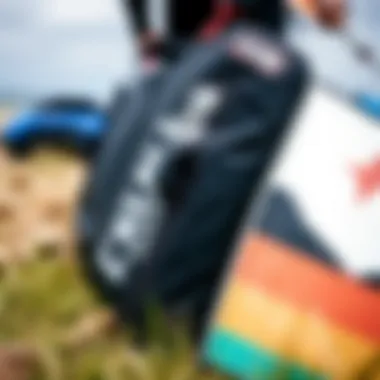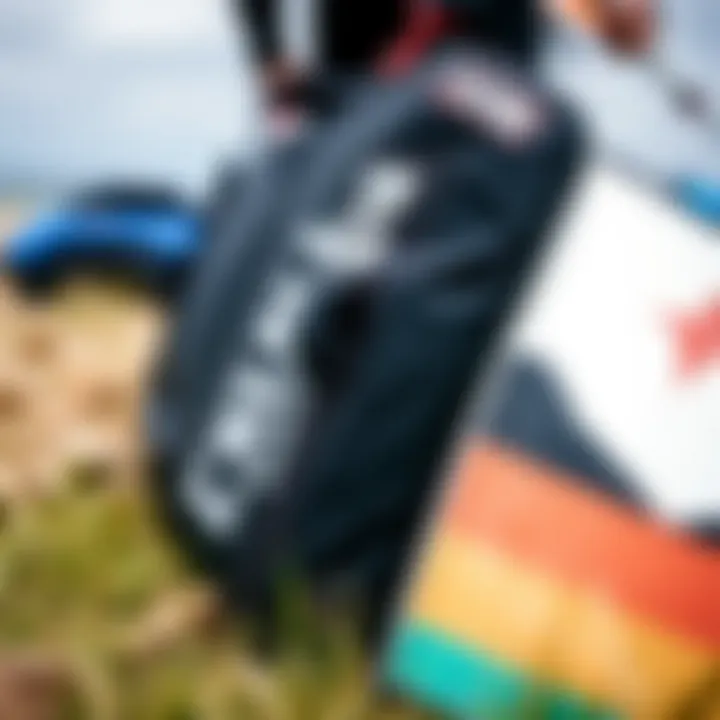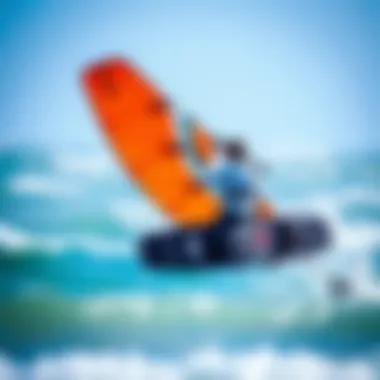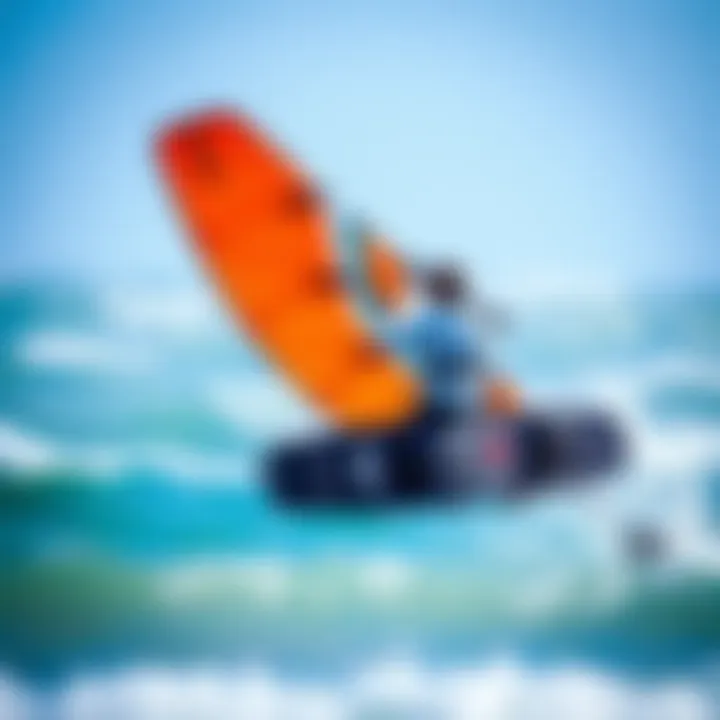Essential Guide to Choosing Kite Surfboard Bags


Intro
Kiteboarding is not just a sport; it’s a lifestyle that brings thrill-seekers and nature lovers together. Among the myriad of gear essential for kiteboarding, the kite surfboard bag plays a vital role in safeguarding your equipment. With kiteboards being relatively delicate and expensive, the right bag ensures they remain in pristine condition, ready for your next session on the water.
In this guide, we'll delve deep into the world of kite surfboard bags. We’ll cover everything from the various types available, to factors influencing your choice based on material and features. Additionally, we’ll provide tips on maintenance and traveling with your gear, enabling both beginners and experienced riders to enhance their kiteboarding experience significantly.
Gear and Equipment
When it comes to kiteboarding, understanding your gear is key. Not only does every piece of equipment influence performance, but it can also impact safety.
Essential Kiteboarding Gear for Beginners
For those just starting out on their kiteboarding journey, here’s an overview of what gear you need:
- Kite: This is your most crucial piece of gear. It comes in various sizes, with larger kites being better for light winds.
- Board: Typically, beginners should go for a wider board, as it offers more stability and makes it easier to stand up.
- Harness: This connects you to the kite and is vital for controlling it properly. Opt for a comfortable fit that allows movement.
- Safety Gear: Don’t skimp on a helmet and impact vest; these can save you a world of pain.
Investing in a solid kite surfboard bag early on is wise. It protects your gear from the elements, dirt, and potential damage while traveling.
Advanced Equipment for Experienced Riders
As you progress in kiteboarding, your gear will evolve:
- High-Performance Kite: You might lean towards a more advanced model with better stability and responsiveness.
- Freestyle Board: If tricks and flipping are your style, a freestyle board is narrower for better performance.
- Wetsuit: Depending on your location, the thickness of the wetsuit will change. Choose one that balances warmth and flexibility.
- Accessories: Consider including a kite pump, spare lines, and a repair kit.
Your kite surfboard bag should meet your advanced needs, with compartments designed to hold all your equipment, including accessories that often go overlooked.
"The right bag not only keeps gear safe but extends its lifespan, ensuring you can enjoy kitesurfing for years to come."
Selecting a high-quality kite surfboard bag isn't just about protection; it’s about enhancing your overall kiteboarding experience, allowing you to focus on refining your skills and enjoying those exhilarating winds.
Understanding the contrast between beginner gear and advanced equipment will help you appreciate the journey you embark on in kiteboarding. With the right tools at your disposal, you’ll be able to elevate your performance and enjoy the thrill of riding the waves.
Prelims to Kite Surfboard Bags
Kite surfboard bags serve as the primary shield for your beloved equipment against the unpredictable forces of nature and the inevitable wear and tear of travel. These bags are not just fabric sacks; they encompass a multitude of benefits designed to protect and prolong the life of your kite surfboard. In an age where equipment can be a significant investment, understanding the nuances of kite surfboard bags can mean the difference between a smooth sailing session or a frustrating trip riddled with mishaps.
Purpose of Kite Surfboard Bags
The foremost purpose of a kite surfboard bag is clear: protection. The ocean is not always gentle. From the sandy shores to rocky beaches, the journey of a kiteboard involves exposure to various hazards. These bags provide a barrier against these dangers, effectively minimizing the risk of dings and scratches. Moreover, kite surfboard bags often come equipped with features like padding and compartmentalization, which further enhances the protective capabilities.
In addition to safeguarding your gear, these bags also streamline transport. Consider the day-to-day hustle of getting to your favorite kiteboarding spot; lugging loose equipment can be cumbersome. A kite surfboard bag simplifies this. It organizes the gear in one package, leading to an easier, more efficient transit.
"A sound bag makes for a happier ride. Protecting your investment is half the battle."
Importance of Choosing the Right Bag
When it comes to selecting a kite surfboard bag, the stakes are high. Picking the wrong size or construction can lead to catastrophic mishaps. Each kiteboard has its unique dimensions and shapes, which means a bag that fits one may not suit another. A bag that’s too big allows the board to move around, increasing the risk of damage during transport. On the other hand, too tight and you could end up with a warped board.
In addition to size, material is crucial. Some bags are made from water-resistant fabrics that keep your gear dry, while others might prioritize lightweight durability. Knowing your individual needs—whether it's a longer traveling distance or just local jaunts—will guide your choice.
Ultimately, investing time to choose the right kite surfboard bag is not merely about convenience; it's about ensuring your gear remains in top shape, resulting in better performance on the water and longevity of your equipment.
Types of Kite Surfboard Bags
When it comes to kiteboard bags, understanding the various types available on the market is essential for any kiteboarder. Each style of bag has its own traits, advantages, and disadvantages. Choosing the right type can make a world of difference in how effectively you can travel with your gear. The right bag can be the difference between a hassle-free trip and a stressful one. Let’s break down the three primary types of kite surfboard bags:
Soft Shell Bags
Soft shell bags are often considered the most popular option among kiteboarders. They are made from flexible materials, which allow them to adapt to the shape of the gear inside.
One of the main benefits of soft shell bags is their weight. They tend to be lighter than hard shell varieties, making them easier to carry. This can be a game-changer when you're navigating through airports or lugging gear across the beach. Additionally, their packed nature allows for more versatility. You can often fit in extra items like wetsuits or other kites.
However, this flexibility does come at a cost. Soft shell bags generally provide less protection against impact. If you’re traveling on a more rugged route or planning on checking your bag with an airline, you’ll want to weigh whether this lack of protection is worth the convenience.
Hard Shell Bags
On the other end of the spectrum, hard shell bags offer robust protection for your kiteboards. These bags are constructed from molded plastic or composite materials, giving them a hard exterior that can withstand many elements.


The primary advantage of a hard shell bag is the top-notch protection it offers. For anyone who values their gear and doesn’t want to risk damage during transit, these are a solid choice. You can toss them around, and they won't easily dent or flex. This sturdiness translates into peace of mind, particularly for expensive equipment.
Conversely, they often come with a higher price tag and can be more cumbersome to carry. Hard shell bags may take up slightly more space when storing but definitely shine when it comes to safeguarding your kiteboard.
Hybrid Bags
Hybrid bags represent a cross between soft shell and hard shell options, attracting those who want the best of both worlds. They usually have a rigid frame that holds its shape, paired with soft materials that provide flexibility where needed.
This unique construction means you can enjoy the lightweight advantage while still protecting your gear from minor bumps and scrapes. Plus, many hybrid bags come with multiple compartments, which can be a lifesaver for organization.
The downside is that they can vary significantly in quality and price, making it critical to do your research. Just because it’s hybrid doesn't mean it’s the best option—it’s about finding the right fit for your personal needs.
Ending
Understanding the different types of kite surfboard bags equips you with the knowledge to make informed decisions. Whether you prefer a soft shell for its portability, a hard shell for maximum protection, or a hybrid for versatility, each option has its own set of advantages. Knowing what benefits you value most lays the groundwork for selecting the perfect bag for your kiteboarding adventures.
"The right bag can serve as your ultimate companion, protecting your gear while you chase the waves and the wind."
Make sure to also check out more detailed guidelines on various product offerings at Wikipedia or discuss your experiences with others on platforms like Reddit.
Once you grasp the essentials of each type, you'll be well-prepared to choose a kite surfboard bag that aligns with your needs.
Key Features to Look For
When it comes to selecting a kite surfboard bag, keeping an eye on key features can make all the difference. Using a bag that includes vital elements can ensure your gear stays protected and travels well. The right features can save kiteboarders from potential heartaches down the line, such as damaged boards or misplaced accessories. Here's what to carefully consider when picking your bag:
Padding and Protection
Padding is a must-have when it comes to safeguarding your kite equipment. The level of padding can vary across models, and it is crucial to choose a bag that offers substantial cushioning. Look for bags that feature high-density foam or specialized materials that absorb shocks effectively. This padding acts as a barrier against the rigors of travel, whether it be on rough roads or in the cargo hold of an airplane.
The benefits of adequate protection are clear. It not only protects the board from dings and scratches but also offers peace of mind, knowing that your investment is safe.
A well-padded bag can turn a disaster into just a small bump on the road.
In addition to the padding, the protection against moisture is equally important. Some bags come with water-resistant materials or coatings that keep your gear dry, which is essential for gear that might spend time in soggy conditions. Choose wisely, as the protection can significantly affect the longevity of your kiteboard.
Size and Fit
Getting the size and fit right is another significant feature to consider while selecting a kite surfboard bag. A bag that is either too tight or too loose can lead to troubles—like the board shifting during transit or being difficult to slide in and out. Each kiteboard is of different dimensions, so it's important to refer to the sizing guides offered by manufacturers.
Most bags are designed to accommodate not only the board but also the foot straps and fins. Thus, look for bags with a fit that is snug yet not overly constrictive. Proper fit can help avoid potential breaks or bends in the board due to impact. Furthermore, ensuring your bag fits within airline regulations can save unnecessary fees or headaches during travel.
Storage Compartments
Smart storage compartments can elevate your kiteboarding experience. The perfect bag isn't just a cavernous space to shove your board; it's equipped with extra pockets that allow you to neatly organize all your gear. Having dedicated pockets for items like leashes, helmets, and even snacks creates easy access when you need it most.
Having everything compartmentalized can save you from sifting through a jumbled mess of equipment:
- External Pockets: Perfect for quick access while you’re on the fly, like stashing an extra hoodie or sunblock.
- Mesh Compartments: Ideal for wet gear; they allow for air circulation which helps to dry things out.
- Padded Straps: Easy to carry and protect delicate items, these can be a game-changer, especially when lugging everything to the beach.
Opting for a bag with ample storage can ensure that everything is in one place and prevent any last-minute panics before heading out on the water.
Considering these key features will not only help you choose the right kite surfboard bag but also ensure that you are set for a smooth ride, both on the water and while traveling. Keep those boards safe, and enjoy every wave!
Materials Used in Construction
When it comes to kite surfboard bags, the materials used in their construction can make or break the experience for the kiteboarder. Choosing the right materials is essential for effective gear protection and long-lasting use. Understanding what goes into these bags can help buyers make better decisions, ensuring that they invest in a product that not only meets their needs but also enhances their kiteboarding adventures.
Water-Resistant Fabrics
Water-resistant fabrics are a non-negotiable feature for kite surfboard bags. When you're out on the water, the last thing you want is your gear to get wet from unexpected splashes or rain. Fabrics such as nylon or polyester are commonly used because they provide a good level of waterproofing while remaining lightweight. Look for materials treated with special coatings that repel moisture; these can significantly prolong the life of your bag.
Investing in a bag made from high-quality water-resistant fabrics ensures that your kite surfboard is shielded from the elements, thus reducing the risk of mold and mildew developing on your equipment. This is especially important considering the environment kiteboarders often navigate, which can be unpredictable and harsh.
"Protecting your gear means protecting your passion. Water-resistant fabrics act as your first line of defense against the elements."
Be sure to check product specifications for terms like "600D polyester" or "ripstop nylon"—these indicate durability and resistance to tearing while maintaining water resistance. If you plan on traveling or storing your bag in challenging conditions, look into bags with an effective waterproof zipper and sealed seams.


Durability and Weight Considerations
Durability is another crucial aspect in the selection of a kite surfboard bag. Kiteboarders know that treats, bumps, and scrapes come with the territory. Therefore, choosing materials that can withstand rough handling is imperative. Fabrics with high denier counts, like those mentioned earlier, are often tougher and more resilient.
However, it's not just about how strong the materials are; weight plays a significant role too. Heavy bags can be cumbersome when hauling gear, especially during travel. Ideally, the materials should strike a balance between being light and incredibly strong. The innovation in fabric technology has led to lighter options that remain durable, allowing kiteboarders to carry their gear comfortably.
Moreover, pay attention to the stitching quality and types of zippers used. Reinforced stitching can provide additional strength not just to the body of the bag but also to the straps and compartments. Check if the zippers are made from high-grade plastics or metals; they should be robust and snag-free, as fiddling with a stuck zipper can lead to frustration.
In summary, the materials used in kite surfboard bags are far from an afterthought. They affect not only the longevity of the bag but also the safety of the gear it carries and the convenience for the user. By selecting a bag with the right combination of water-resistant fabrics and durable yet lightweight materials, kiteboarders can ensure that their gear remains protected and their outdoor experience is uninterrupted.
Maintenance of Kite Surfboard Bags
Proper maintenance of kite surfboard bags is vital for several reasons. First and foremost, these bags serve as a shield, protecting costly gear from damage during transport and storage. If not well cared for, the bags themselves can wear out quickly, compromising their ability to safeguard your surfboards. Regular maintenance not only prolongs the life of the bag but also ensures that your equipment is ready for action whenever you hit the waves.
Cleaning Techniques
Keeping your kite surfboard bag clean is a straightforward yet essential aspect of maintenance. Sand, saltwater, and debris can quickly accumulate, leading to deterioration of the fabric and zippers. Here are some effective cleaning techniques:
- Rinse Off Regularly: After every surf session, take a moment to rinse your bag with fresh water. This helps remove salt and sand that can cause wear over time.
- Spot Clean: For specific stains or areas that may have absorbed dirt, use a mild detergent mixed with water to gently scrub the affected area. A soft cloth or a sponge works well here.
- Air Dry: After cleaning, let your bag air dry in a shady spot. Direct sunlight can damage the materials over time, so it’s wise to avoid long exposures.
- Avoid Harsh Chemicals: While it may seem tempting to use strong cleaners, these can damage the fabric's integrity. Stick to gentle soap solutions.
Remember: A clean bag not only lasts longer but also prevents any contamination from transferring onto your surfboards.
Storage Practices
The way you store your kite surfboard bag can have a big impact on its longevity and efficacy. Here are some best practices:
- Keep It Dry: Always store your bag in a dry area. Moist environments can lead to mold and mildew, which may weaken the fabric and create unpleasant odors.
- Avoid Heavy Weight: When storing your bag for extended periods, refrain from placing heavy items on top of it. Excess weight can cause deformation or stress on the zippers and seams.
- Use a Protective Cover: If possible, use a dust cover when storing your bag, especially if it’s going to be sitting for a long time. This helps keep it clean and free from dust.
- Check for Pests: Especially in areas where bugs might take shelter, regularly check your bag for any signs of pests, as they can create unwanted damage.
Proper maintenance of kite surfboard bags is not particular rocket science but it certainly goes a long way in keeping your gear in top-notch condition. With simple cleaning and thoughtful storage practices, you can ensure your kite surfboard bag serves its purpose effectively.
Travel Tips for Kiteboarders
As kiteboarders set out to catch the wind and ride the waves, they should not overlook the importance of proper travel preparation. Traveling with kiteboarding gear involves more than simply tossing your kite surfboard bag in the back of a car. There are several critical elements to keep in mind to ensure that your equipment reaches its destination safely and that your experience remains enjoyable and stress-free.
When you’re out on the road or catching flights to your next kiteboarding spot, having a clear strategy can make a world of a difference. Fortunately, there are straightforward tips and guidelines that can help you navigate the nuances of traveling with kiteboarding gear. This section zeroes in on two essential aspects: understanding airline regulations and mastering efficient packing techniques.
Airline Regulations and Fees
One of the first hurdles for kiteboarders when traveling by air is to grapple with airline regulations. Typically, each airline has its own policies regarding the transportation of sports equipment, which can be frustrating. Familiarizing yourself with these particular guidelines can prevent you from any nasty surprises at check-in.
- Baggage Size and Weight Restrictions: Many airlines enforce strict weight limits, generally ranging from 23 kg to 32 kg for checked bags. This means that lightweight board bags can offer you a slight edge, allowing you to pack more without exceeding these limits.
- Extra Fees: Often, transporting kiteboarding equipment incurs extra fees, sometimes hefty ones. These fees can vary based on the airline and the routes, so checking these beforehand can save you a few bucks. Some airlines might treat kite gear as sporting equipment, hence applying a surcharge that differs from standard luggage.
- Advance Notice: It’s advisable to inform the airline in advance that you’ll be traveling with a kite surfboard bag. This way, they can appropriately manage your reservation and ensure space availability. Also, this could save you from any potential conflicts at the time of boarding.
- Documentation: Some airlines might require proof of equipment dimensions or weights. Keeping this information at hand can smooth the check-in process.
Always remember to double-check with your airline at least a week before flying to ensure you have the most up-to-date information on regulations and fees.
Packing Techniques
Packing your kite surfboard bag efficiently can drastically reduce the risks associated with traveling. It’s an art and perhaps a bit of science. An organized packing method ensures that equipment is protected while optimizing space in your bag. Here are several techniques to consider:
- Layering: Place the larger items, like your board, at the bottom, and then add padded clothing or towels to surround it. This setup provides both structure and extra cushioning against impacts.
- Separate Components: Keep kites, lines, and harnesses separate to minimize tangling. Consider using compression bags or cube organizers to keep everything neat. This method also expedites unpacking at your destination.
- Protective Covers: Many kiteboarders often overlook using protective sleeves for their individual components. A simple bag for your kite can prevent abrasions and punctures. Likewise, covers for fins or straps can reduce the risk of damage during transit.
- Weight Distribution: Balance the load when packing to make it easy to lift or maneuver your bag. An evenly distributed weight can also avoid unnecessary strain on zippers and seams.
- Important Gear at Hand: Keep emergency essentials like repair kits, sunscreen, and even a change of swimwear close to the top or in side compartments. Should delays occur, having immediate access can be a lifesaver.
Taking the time to plan and execute effective travel strategies enhances the experience of kiteboarding, from the point of departure to the moment your feet hit the water. Every kiteboarder, whether a beginner or seasoned traveler, can benefit immensely from understanding regulations and employing smart packing techniques. This ensures the kiteboarding gear stays in prime condition and that the journey remains as enjoyable as the thrill of flying on the water.
Best Brands in the Market
When it comes to selecting a kite surfboard bag, choosing the right brand can make all the difference. The best brands not only create quality products but also offer reliable support, innovation in design, and a commitment to customer satisfaction. These factors create a strong connection between the user and their gear, enhancing the kiteboarding experience. A well-regarded brand can impart a sense of confidence, knowing that your equipment will be protected no matter where the adventures take you.
Overview of Top Manufacturers
A few key players dominate the kite surfboard bag market, known for their innovative features, durability, and praise from the kiteboarding community. Some of the most notable brands include:
- Naish: This manufacturer is renowned for its robust line of kite surfboard bags. Their products often incorporate high-density foam padding and water-resistant materials, making them ideal for turbulent travels.
- Ocean Rodeo: A brand that prides itself on functionality and style. Their bags come with unique design elements that cater to the needs of various riders, whether they’re just starting or seasoned veterans.
- Mystic: This company combines sleek designs with practicality. Mystic bags often come with ample storage options and reinforced sides for added durability.
- Duotone: Known for their commitment to performance, Duotone bags are tailored for kiteboarders looking for the latest features in bag design, accommodating everything from kiteboards to accessories seamlessly.
- Prolimit: A manufacturer focusing on producing excellent quality bags at competitive prices. Their offerings are often lightweight yet sturdy, making them popular among budget-conscious riders without compromising quality.
The specific features and construction methods used by these manufacturers cater to a wide variety of needs, ensuring that every kiteboarder can find a bag that suits their style, budget, and travel demands.
Comparative Analysis of Features
In assessing the best kite surfboard bags, it’s vital to compare specific features offered by the leading brands. Each brand tends to have its own selling points that cater to different segments of riders:


- Padding and Protection: Many top brands offer varying levels of padding. For example, Naish bags often feature thicker padding for extra safety, while other brands like Mystic might focus on lighter materials for versatility during transport.
- Storage Options: Users frequently consider storage when selecting a bag. Duotone bags typically include multiple compartments for convenient organization, whereas Ocean Rodeo focuses on streamlined designs that minimize bulk.
- Weight Considerations: The weight of the bag is crucial, especially for traveling. Prolimit employs lightweight materials to help minimize the load, and riders appreciate this feature when heading to the beach, especially after a long day on the water.
- Durability: Brands like Mystic emphasize durability in their products. They often use heavy-duty materials that hold up better against wear and tear over time.
- Price Point: Cost is an integral consideration. While some riders might splurge on top-tier brands like Naish or Duotone, others may find that brands like Prolimit offer competitive features at a more accessible price.
Budget Considerations
When it comes to selecting a kite surfboard bag, budget considerations often take center stage. It is essential to weigh your options carefully to ensure you get the best value for your money. The right bag can mean the difference between smooth sailing and a rough ride when packing up for your next kiting adventure. This section discusses key elements that interplay between budget and quality, and how they can significantly impact your decision-making process.
Cost vs. Quality Analysis
In the world of kite surfboard bags, a common adage rings true: you get what you pay for. A cheaper bag might save you some bucks upfront, but you could end up with a flimsy product that doesn’t hold up against the rigors of travel or the elements. Here are some crucial points to consider:
- Material Quality: High-quality bags usually come with durable materials that withstand wear and tear. For instance, polyester or nylon bags offer a level of water resistance, which is vital for protecting your gear from moisture.
- Padding and Protection: Investing in a bag with superior padding can save your board from damage during transportation. Cheaper bags often skimp on this feature, putting your equipment at risk.
- Longevity vs. Immediate Price: A bag that costs a bit more now may last longer and perform better over time, ultimately costing less in replacements.
Ultimately, finding the right balance between cost and quality can require some research and introspection. Reviews and recommendations can be invaluable during this process.
Value for Money Insights
Determining value for money is a critical aspect of any purchase, especially when it comes to kite surfboard bags. Here’s how to gauge if you're making a wise investment:
- Warranty and Return Policies: A reputable brand typically offers a warranty, ensuring protection on your investment. Additionally, favorable return policies can give peace of mind if the bag doesn’t meet your expectations.
- User Reviews: Engaging with the kiteboarding community through forums, such as Reddit or industry-specific groups on social media, can provide insight into what others perceive as valuable. Feedback from seasoned riders often highlights which bags perform exceptionally well over time.
- Features Versus Necessity: Sometimes bags are laden with features that might not be essential for your needs. Analyze what truly matters for your situation—do you require extra compartments, or will a simpler design suffice?
"The best kite surfboard bag for you is one that strikes a perfect balance between your needs and budget. It’s not just about buying a bag; it's about making a long-term investment in protecting your gear."
User Reviews and Experiences
User reviews and experiences are not just mere anecdotes; they are vital insights that help prospective buyers navigate the complex world of kite surfboard bags. By examining how individuals from varied backgrounds experience different brands and models, one can gain a clearer picture of what to expect when choosing a kite surfboard bag. This feedback provides a real-world context that technical specifications often fail to convey. It encompasses aspects such as durability, ease of use, and even practical tips that may not be included in product descriptions.
When potential buyers take the plunge into the market, they want to know the genuine pros and cons of different products. User experiences act as a compass—pointing in the direction of quality, or sometimes warning against potential pitfalls that could come with a bag that looks great on paper but doesn’t hold up in practice.
"Nothing beats hearing from someone who's been there and done that, especially in a world where every gram matters on the water."
Feedback from Beginners
For many beginners, the world of kiteboarding can be overwhelming. After investing time and money into their sport, new riders often find themselves second-guessing their choices, particularly when it comes to protective gear. Reviews from beginners can reveal a wealth of practical knowledge.
Many novices often point out what they wish they had known before purchasing a bag. Here are some key takeaways from their experiences:
- Size Matters: Many beginners highlight that getting a bag that’s too small for their board can lead to frustration both in travel and storage. Reviews often stress the importance of measuring your board accurately before making a purchase.
- User-Friendly Features: Beginners tend to appreciate bags with simple, intuitive designs that make packing and unpacking hassle-free. Features like wide openings or easy-access pockets can significantly enhance user experience.
- Weight Considerations: New riders frequently mention how weight affects their overall experience when lugging their gear around. A lighter bag often means a more enjoyable session, especially when moving from point A to B.
By collecting and analyzing these reviews, it becomes evident how invaluable they can be for newcomers. They create a solid foundation upon which to base purchasing decisions, steering them towards bags that genuinely fit their immediate needs.
Insights from Experienced Riders
In contrast, seasoned kiteboarders offer a different kind of insight into kite surfboard bags. Their feedback sheds light on durability, long-term functionality, and the nuances that come with repeated use over time.
Experienced riders have developed an eye for quality that often comes from trial and error. Their insights typically touch upon several important facets:
- Longevity Under Pressure: Many seasoned boarders will discuss which materials hold up best against the elements. They’ve often had multiple bags over the years and can compare, citing specific experiences where certain fabrics failed or succeeded in protecting their gear.
- Customizable Options: Experienced kiteboarders value the options for customization that some bags provide. Whether it's adjustable straps or removable compartments, small features tailored to your preferences can make a big difference.
- Real-World Use Cases: It’s not just about storage; it’s about transportation too. Detailed accounts include experiences with airline regulations and the practicality of wheels versus handles. They have often faced delays, peak seasons, or tricky transfer situations where bag performance made all the difference.
Sharing these experiences helps bridge the gap between beginners and seasoned riders. It fosters a community where knowledge is shared and everyone, at every level, can benefit by making informed choices.
Ending
Choosing the right kite surfboard bag plays a significant role not only in safeguarding one's investment but also in enhancing the kiteboarding experience. A well-chosen bag not only protects boards from damage during transport but also offers convenience and organization for gear required on those windy days. It serves as a home for your equipment when heading to the beach or traveling across the globe, making it indispensable for any kiteboarder.
Summarizing Key Points
As we've explored throughout this guide, a few critical factors emerge when considering a kite surfboard bag:
- Types of Bags: Soft shell, hard shell, and hybrid bags cater to different preferences and transport needs. Each type has its own set of advantages, like the flexibility of soft bags versus the rigidity of hard cases.
- Key Features: Important attributes such as padding, storage compartments, and overall fit can make a huge difference in maximizing efficiency and comfort when on the move.
- Materials: The fabric and build quality determine the durability and water resistance of the bag, impacting its longevity.
- Maintenance: Proper care and storage practices prolong the life of the bag and, fundamentally, protect the gear inside.
- User Insights: Hearing from both novices and seasoned riders about their experiences provides a practical lens to see which products genuinely deliver.
In essence, the selection process should align closely with individual needs, whether one is looking for something lightweight and compact or robust and feature-packed.
Final Thoughts on Selecting a Kite Surfboard Bag
Ultimately, selecting the right kite surfboard bag isn’t merely about the cost or appearance; it’s a thoughtful decision weighing functionality versus style. There's a balance to find in ensuring that the bag meets specific travel needs while also being protective.
Moreover, the environment where the bag will mainly be used should influence the choice. Frequent flyers will appreciate a bag with travel-friendly features, while local riders might prioritize ease of handling and everyday functionality. Pay attention to user reviews and experiences to gauge the bags' performance in real-life situations, as this can often reveal the subtle differences among similar models.
In the end, the goal is not just to pick a bag, but to select one that aligns with your personal kiteboarding journey, ensuring that every session is enjoyable and your gear is kept in top shape.
"A kite surfboard bag is more than just some fabric; it's the guardian of your freedom on the water."
For additional information related to kiteboarding and equipment care, consider checking websites like Wikipedia, Britannica, and engaging discussions on Reddit.















